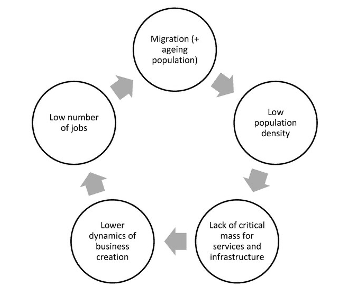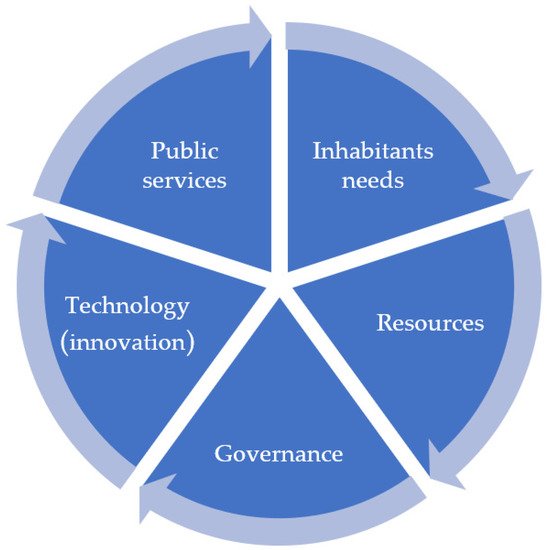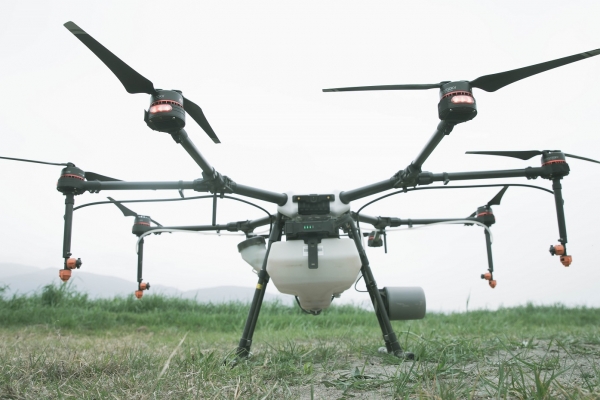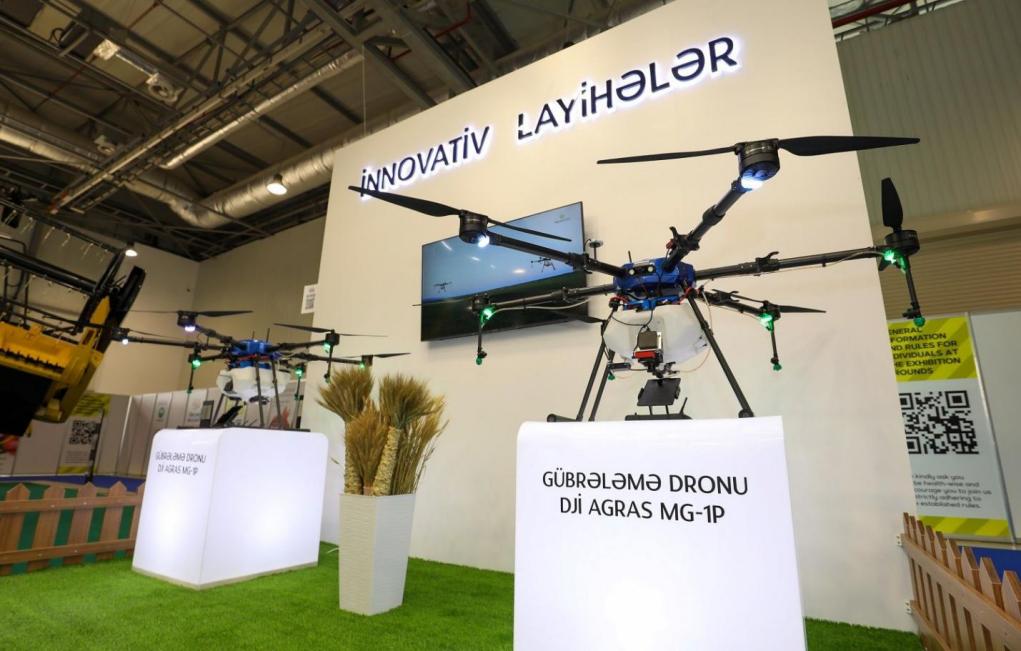Introduction
Currently, people living in rural areas is 47.2 percent of the total population in country (4,707,600 people as of January 1, 2019), and their main source of income is agriculture [1]. In 2005-2015, the oil boom led to regional development, poverty eradication, and especially to strengthening support for about one million refugees from occupied Nagorno-Karabakh and surrounding areas. In order to keep prosperity from a sharp decline in prices of crude oil on the world stock market, the government launched the increase of agricultural development as the main strategic policy starting from the end of 2014. Targets for increasing agricultural products that contribute to the country's exports due to the efficient usage of land and water reserves and the practicing modern agricultural technologies have been determined.
Starting from 2015, new large farms-agroparks are being created with state support. These are agro-industrial farms that aim efficiently organized agricultural business with the application of advanced farming technologies, including modern watering systems. A decision was made to establish 51 agricultural parks, 34 of which are already operational. Government policies are also being developed to develop small farms to maintain prosperity in rural areas.
World leaders revealed at the G20 Summit in Osaka in 2019 that the idea of a "smart city" had been thoroughly discussed and that an alliance had been formed to define the required worldwide framework that would unite present companies striving to create those areas. In international terms, a "Smart village" is the means to solve the primary issues confronting the rural people and generate fresh economic prospects in more significant rural regions. Though the word is employed in several ways by economists, "smart villages" are usually used to describe tiny urban and rural networks that advance development by means of creativity, knowledge, and technology.
The smart rural strategy to be executed in Azerbaijan comprises five components: housing, production, social services, "smart agriculture," and alternative energy. The energy requirements of the 200 houses are met exclusively by alternative energy sources. The implementation of "smart village" technologies in freed regions is anticipated to mitigate issues such as migration of youth from rural areas, employment scarcity, diminished economic activity, inadequate infrastructure, and low population density. The implementation of "smart-village" technologies enables these regions to disseminate social ideas and initiate micro and small enterprises within the rural populace.
Materials and methods
The objective of the study conducted on analyzing the current situation, create opportunities for the expansion of modern farming applications across the country. Information from official resources, statistical objects, as well as external reliable materials were used as the official source of information. The analytical research approach grounded in qualitative indicators was chosen for the preparation of the study task. The study analyzed worldwide experience by employing the methodologies and research of pertinent international organizations. The conversion of gathered quantitative data into descriptive-analytical metrics provides a comparative analysis of events and trends in sustainable urbanization.
Taking into account the current demand and climate change trends in the country, measures are justified to expand the application of smart agriculture. Generalizations are made for the entire territory of the country. From a conceptual standpoint, the usage of smart technologies is taken into account as a significant measure in terms of effective usage of unrecoverable resources, a component of the adapting policy fighting climate change, highly efficient agricultural production and an important
measure for the easy operation of agricultural technologies beginning from the farm to the administrative management.
Smart Village-Theoretical Foundations of the Concept
The smart village concept serves as a proactive solution to a series of interconnected phenomena and processes increasingly recognized inside the EU, often referred to as a vicious cycle of decline [8] (Figure 1). The literature survey indicates that the concept of a smart village is mostly linked to goals such as enhanced wellbeing, energy efficiency, a low-emission economy, diminished disparities between urban and rural regions, and improved economic situations. There is a focus on enhancing governance efficiency, advancing rural livelihoods and human resources, and addressing concerns such as bolstering catastrophe resilience and mitigating energy poverty [9][10].

Figure 1. Vicious circle of decline in rural areas
The notion of the smart village initially emerged in 2015. Subsequently, it was utilized to support programs in Africa and Asia. The primary emphasis in these instances was on the accessibility of modern energy sources, fundamental education and healthcare, and food security for the inhabitants [11][12].
A fundamental premise of the smart villages concept is the acknowledgement that continuous technological advancement may generate new prospects for revenue enhancement and service provision in rural regions. To significantly enhance the standard of living in rural areas, it is essential to integrate this notion with other programs [13]. The sustained enhancement of local communities can only transpire if the undertaken efforts are congruent. They ought to be included in a thoughtfully devised, recognized, and socially endorsed rural development initiative.
Alongside traditional infrastructure investments, commercial development, human capital enhancement, and civil society advancement, the smart village concept emphasizes the integration of cutting-edge technological innovations. Emphasis is placed on access to and utilisation of public e-services, environmental conservation through enhancing the circular economy, innovative information and communication technology (ICT), and the execution of regionally defined smart specialisations, such as in tourism, culture, or the promotion of local products, including agricultural and food items.
For several years, it has been underscored that affluent cities and those with greater population density are the initial beneficiaries of emerging technology [14][15]. Rural areas, however, exhibit specific delays in the adoption of novel solutions [16][17]. This dynamic results in the outermost regions being nearly destined for developmental disadvantage, a relative decline in living conditions, and the subsequent depletion of their human capital and financial resources [18]. Consequently, certain current studies suggest that the function of growth poles need not be exclusively linked to urban regions [19]. External regions can also stimulate internal development impulses. Nonetheless, this necessitates the establishment of local demand, which demands a specific critical mass; in the absence of such a mass, developmental impetus must be derived from endogenous local resources (Figure 2).

Figure 2. The factors involved in the model of smart village
The technologies used by smart cities are also large scale, and the following can be cited as the basics:
Application Programming Interface (API)
Artificial Intelligence (AI)
Cloud Computing Services Cloud Computing Services
Monitoring panels / Dashboards
Machine Learning
Machine-to-Machine Communications
Mesh Networks / Mesh Networks
Fiber optic line
(www.iksadkongre.com/economy)
The phrase "smart villages" typically denotes tiny urban and rural networks that leverage innovation, knowledge, and technology to foster development.
Smart infrastructure and services
- Implementation of contemporary urban planning criteria
- Construction of fully insulated individual ecological residences with revolutionary building materials
- Provision of high-speed internet and television services
- Coordination of e-learning and training programs
- Facilitation of e-health services
- Utilization of alternative and renewable energy sources
- Implementation of advanced heating and cooling systems
- Development of intelligent transportation and logistics infrastructure
- Deployment of smart irrigation technologies
- Prudent waste management practices
Smart businesses and farms
- Private investment and employment initiatives
- Platforms facilitating seamless access to domestic and international markets
- Development of tourism and recreational zones
- Intelligent agriculture: installation of smart fields and farms, implementation of pasture management systems, etc.
- Digital banking and financial services
Smart management
- Creation of an electronic village management system
- Implementation of community-oriented smart governance
- Establishment of a data analytics center
- Facilitation of access to e-government services
- Execution of an electronic agricultural information system (EITIS)
3. Projects for smart agriculture development in Azerbaijan
The "State Program for Socio-Economic Development of the Regions of the Republic of Azerbaijan in 2019-2023" approved by Decree No. 500 of the President of the Republic of Azerbaijan dated January 29, 2019 was adopted [2].
Some examples of smart agriculture activities according to the action plan of this in the regions of Barda and Ismayilli, smart village programs are proposed to be realized to support technological applications in rural areas.
Table 3.
Few projects of smart agriculture operations that are planned to be implemented as part of the State Program for the Socioeconomic Growth of the Republic of Azerbaijan [3]
|
No |
Name of activity |
Year |
Executor |
|
7.1.69 |
Establishment of new agro-gardens (157 ha) and equiping of drip irrigation system along the Salyan-Bilasuvar part of the New Alat- Astara highway Establishment of modern agro-gardens (45 ha) and drip irrigation system in Salyan district along the Alat-Astara highway; Building new agro-gardens (35 ha) and installing drip irrigation system in km 34-42 of the Baku-Guba Road (Absheron district). |
2019-2023 |
Ministry of Ecology and Natural Resources, Regional Executive Authorities |
|
7.1.75 |
Continuation of contaminated land cleanup measures, including: Remediation of the polluted area (100 ha) surrounding the defunct iodine-bromine facility in the Surakhani region, including planting, greening, and installation of a drip irrigation system. |
2019-2023 |
Ministry of Ecology and Natural Resources, State Oil Company |
|
7.1.86 |
Preparation and realization of pilot strategies related to the use of recoverable energy sources in irrigation |
2019-2021 |
Ministry of Energy, Ministry of Agriculture, “Amelioration and Water Management” OJSC, local executive authorities |
|
|
Establishment of agricultural production and processing factories in Barda district, including: Construction of an agro-complex for cotton grow and processing; Agro-park for cotton cultivation field with 2,000 hectares; sugar beet, corn, soybean, barley growing field and processing area in 1500 hectares; Realizing of the "Smart Village" project; Construction of a granary; Foundation of a grain cultivation (soft wheat) smart farm covering 50 hectares; Building collection spots for drying wet cocoons. |
2019-2023 |
Entrepreneurs, Ministry of Agriculture, Ministry of Economy, “Azerbaijan Industrial Corporation” OJSC, Local Executive Body |
|
|
Ismailli district: agro-park for cotton, horticulture and vegetable planting field covering 5826 hectares; Planting potato field in 50 ha; Building dairy products focused farm of 1200 cows; Construction of wheat, corn, barley and etc. processing points; Establishment of a grain supply point; Building a granary; keep on projects to increase pivot irrigation focused points. |
2019-2023 |
Entrepreneurs, Ministry of Agriculture, Ministry of Economy, local executive power |
|
|
Agsu district: Creation of modern livestock farms; Creation of seed breeding and fodder complex; Expanding pomegranate gardens and processing points; Creation of farm on 1500 ha (500ha of which watered by pivot irrigation system); New pick-up centers for wet drying cocoon; Creation of smart horticultural farming subjects; Increasing projects to help grow interest in beekeeping. |
2019-2023 |
Entrepreneurs, Ministry of Agriculture, Ministry of Economy, Local executive power |
Source: Statistic Committee of Azerbaijan Republic
First smart village – Agali
The main components of the "Smart Village" project
The initial "Smart Village" pilot project focuses primarily on five components. These areas include housing, industry, social services, "smart agriculture," and green energy. The idea is to construct 200 individual houses in the region utilizing fully insulated and modern materials for construction. Additionally, indoor engineering communication and central heating will be based on intelligent technology. In these settlements, modern schools, kindergartens, health centers and electronic management facilities will be constructed, as well as tourism infrastructure. Alternative sources of energy will be installed in all houses, social institutions, administrative and public catering buildings, and processing and production facilities for agricultural products. Additionally, technicians from Turkish, Chinese, Italian, and Israeli companies will engage in the project's execution [4].
"Smart village" is not only about agriculture. Application of modern urban planning standards, "smart" lighting of streets, construction of warm and cold-resistant ecological houses, household waste management, installation of hydropower plants, solar panel plants, use of biogas energy are among the main components of this concept. If we take into account the construction of modern schools, kindergartens, polyclinics and electronic management centers, and the formation of tourism infrastructure in these villages, the picture will be clear. The provision of all residential houses, social facilities, processing and production of agricultural products with alternative energy sources shows the extent to which the "Smart Village" has advantages.
"Smart village" system based on high technologies
Robots are already being put to use in a wide variety of industries, including the manufacturing industry and the automobile industries, to fulfill the demand for higher levels of precision and security while simultaneously lowering the industry's overall production costs. Due to the implementation of "Smart farms," the Netherlands surpasses Azerbaijan by a significant margin in the production of agricultural goods, despite having a land area that is only half as large as that of Azerbaijan. Technology companies based in the Netherlands are among the most innovative in the world when it comes to developing answers to the numerous problems that plague modern society.


Picture 2. Drones used for fertilization [7]
Drone technology should be widely used in both irrigation and planting. Remote control in the livestock sector should be expanded. Robovalley, which is located on the campus of Delft University of Technology, offers businesses a place to test out new concepts in the fields of artificial intelligence and robotics. For instance, researchers at TU Delft's MAV Lab are working on the development of small swarms of drones that are capable of mapping difficult-to-explore areas. If successful, these drones could have a wide variety of applications, such as monitoring construction, providing emergency services, and even regulating crop production [5]. Implementing this type of technology to Azerbaijan and applying it in local farms, also in Aghali Smart village, can be beneficial in terms of strengthening the control of fields, less use of human labor and time. Monitoring of large croplands can be done in a shorter period of time.
Rural areas are able to overcome geographical hurdles to development created by factors such as distance or low population density when development strategies are implemented that are focused on technology and innovation. In general, rural areas have less access to infrastructure, services, and markets when compared to metropolitan areas. Additionally, due to the less population density, rural areas do not benefit from the advantages of agglomeration and economic activity concentration. The application of technology and innovative thinking can assist rural communities in sustaining in three different ways. First, it has the potential to provide people in rural areas with access to e-services (remote medical care, virtual schools, virtual logistics platforms for farmers, mobile applications and e-governance platforms), thereby lowering the expenses to provide services to each individual. Second, it has the potential to boost the labor effectiveness and operational efficiency of local businesses, in addition to the creation of jobs and means of subsistence. Opportunities such as e-commerce platforms that were pioneered in rural China by Taobao (Alibaba), which enable rural producers to sell directly to urban consumers, have the potential to connect rural merchants to urban markets and global markets that they would not have access to otherwise. Last but not least, such platforms can hasten the adoption of innovations that eliminate information imbalances and generate "information products and services" for nearly no cost, such as digital payment systems, music, and news [7].
According to the "Smart Village" concept, the electronization of the process enhances production capabilities. "Smart Village" is an automated, centrally controlled and co-managed system of the entire platform, from the irrigation system to the cultivation of the land and harvesting, and it also involves the application of the most advanced technologies and technology transfers. The integration of this system into other areas of rural infrastructure - alternative energy sources and modern transport system - will complete the concept of "Smart Village".The implementation of intelligent urban and rural solutions, including monitoring electricity usage, smart lighting, and interactive street lights, can substantially decrease greenhouse gas emissions while simultaneously reducing electricity and heat consumption. For instance, intelligent rural solutions, including drone surveillance of agricultural land and the direct transfer of data to villagers' smartphones through sensors, can enhance efficiency in this sector. Initially, the equipment employed in all sectors of agriculture and livestock operations are becoming increasingly intelligent. All agricultural tasks are administered using automated technologies and mobile devices.
Conversely, a smart village will provide socializing and educational activities for children, youth, and women, with all information accessible via smartphones, encompassing daily milk production, chicken egg weights, air quality, and fuel levels of agricultural machines. (azerbaijan-news.az, 2021) The smart village concept entails the provision of electronic services to farmers, including automated irrigation, greenhouse management, fertilizer application, chicken operations, milk collecting, and a beekeepers early warning system. A peasant farmer can remotely control and monitor irrigation processes at any time with a smart irrigation system via a mobile phone. Consequently, bees can be monitored in apiculture with the GPS Tracking System. Intelligent livestock, security systems, and automated milking are anticipated to facilitate livestock management.
The establishment of smart cities in contemporary society can address numerous challenges posed by globalization and the Fourth Industrial Revolution. Enhancing the sustainability, inclusivity, and security of cities has been recognized as one of the United Nations Sustainable Development Goals (SDG 11).(globalgoals.org)
Sustainable Development Goal 11 (SDG 11), designated "sustainable cities and communities," is one of the 17 Sustainable Development Goals established by the United Nations General Assembly in 2015. The explicit objective of SDG 11 is to "Create inclusive, safe, resilient, and sustainable cities" (globalgoals.org). The 17 Sustainable Development Goals acknowledge that actions in one domain influence results in others, and that development must harmonize social, economic, and environmental sustainability. When effectively planned and administered, urban growth can achieve sustainability and foster collective prosperity.
The Sustainable Development Goals Report 2022 assesses the advancement of the 2030 Agenda for Sustainable Development, utilizing the most recent data and estimations to monitor worldwide progress across the 17 Goals, accompanied by a comprehensive analysis of specific indicators for each Goal. This report, compiled by independent experts from the Sustainable Development Solutions Network, evaluates the progress of each country towards achieving the sustainable development goals established for 2030.
In the 2022 report, Azerbaijan improved by 5 points over the previous year, achieving a score of 73.5 out of a potential 100 points. Azerbaijan presently has the 50th position among 163 nations in the "Sustainable Development Goals (SDG) Index."
The proposed "smart village" in Azerbaijan is distinctive. The Smart Village project in Azerbaijan distinguishes itself from analogous initiatives in other nations by encompassing a majority of the available smart solutions. A significant distinction is their intention to transform historically established and traditionally constructed communities inside the European Union into "smart villages" through the implementation of intelligent solutions. A new "smart village" initiative is being executed in Azerbaijan's liberated regions through the reconstruction of all infrastructure. Adhering to international standards, incorporating all elements, particularly those suitable for students, in the development of “smart villages” can enhance efficiency and improve the likelihood of achieving successful project outcomes. It is essential to ascertain the ideal dimensions of the "smart village" within the nation to enhance the efficacy of implementing similar initiatives in other places. The implementation of this concept in comparatively small settlements may lack economic viability.
Certain services in "smart villages" may be disseminated over multiple settlements, resulting in enhanced efficiency. A standardized waste management system might be established to link multiple villages.
A segment of the population designated for resettlement in the villages has resided in various cities and towns around the country for the past 30 years, and the residences constructed in the “smart villages” may resemble urban or town-style housing, hence reducing investment expenses. Global evidence indicates that the efficacy of various "smart village" initiatives is contingent upon the population size of the village.
Some villages in the European Union's "smart village" project can be classified as "smart settlements". They propose prioritizing "smart settlements" above "smart villages" in Azerbaijan to improve project effectiveness. Building "smart settlements" with a car garage in the basement and 3-story residential complexes with commercial amenities on the first level may be more cost-effective. Using a public-private partnership (PPP) model to construct and develop "smart villages" in freed regions can decrease the strain on the state budget while also ensuring project sustainability. To successfully implement the "Smart Village" initiative, individuals must have specific intellectual training, abilities, and skills. The knowledge and skills of traditional villagers differ from those of "smart village" members. To ensure sustainable development, residents of "smart villages" must have up-to-date technical expertise. The concept of a "smart village" is new, hence there are few examples of its economic efficiency. This shows that such programs fall within the category of social projects.
To improve project efficiency, it is recommended that "smart villages" in liberated regions be student-oriented, taking into account the region's diverse geography and economic conditions. Implementing the "Smart Agriculture Concept" in the region can boost labor productivity, production, and promote long-term growth. (Ağıllı şəhər ve kənd konsepsiyası, 2021).9 Implementing "smart rural tourism" in tourist-friendly villages can boost socio-economic development in some regions. As a pilot project, analyzing the Smart Village project's successes and failures will take time, both overall and per component. Projects in other freed areas can only be evaluated after implementation.
What will "Smart Village" give to a simple farmer?
The main question that arises in connection with this innovative initiative is: What will the simple farmer get from this project and how will the "Smart Village" positively affect the farmer's income and lifestyle? The answer is clear - today, the use of manual labor in agriculture around the world has decreased to a minimum, and new technologies are used more in the agricultural sector [5]. Field spraying is done by drones, harvesting is done by computerized techniques, and modern irrigation systems are used to save water resources. Most importantly, all these processes are controlled from one center, the application of technologies allows saving resources, optimizing costs, and increasing revenues. The "Smart Village" project will play an important role in improving the living conditions of the people who will return to our villages that will be restored, and in the integration of our farmers who will be engaged in the agrarian field into the "smart agriculture" system.
Conclusion
At the moment, because of inconstancy in crude oil prices, government put goal to make reforms and bring technologies to non-oil sector, used by countries with advanced agriculture.
Since farming is a major source of earnings and the main activity of people living in suburban areas, the officials are expected to attract investments for modernization of this sector in the coming years.
The implementation of innovative agricultural technologies is linked to limited resources for water and land, ecological degradation, heavy reliance on imported goods, the demand for food security to meet the rapidly increasing population, and the requirements for rural sustainable growth. New agricultural practices are being adopted by the public sector as well as the private industry. Increased investments in resource-saving and labor-intensive technologies are required in the various areas of Azerbaijan as a result of the current trends and needs in agricultural growth. It is recommended that this strategy receive support in the following four areas:
- The widespread implementation of cutting-edge technology in agricultural settings, as well as the enhancement of infrastructure pertaining to irrigation and recycling.
- The investigation and development of alternative forms of energy that can be used in agriculture;
- The implementation of innovative agricultural practices that save land, water, and energy while simultaneously increasing production levels;
- The development of regional infrastructure for agricultural harvesting and the preparation of food.
Agricultural efficiency of small landowners, especially the issue of efficient use of agricultural land resources, is of great importance. At that point, government policy stimulates the realization of land allocation projects to guarantee that technological innovations can be easily transferred to the present agricultural production. Simultaneously, smart software for small households must be regarded as a necessary component of development of regions.
Human labor in planting, harvesting and transporting the product should be reduced to a minimum level. Human labor should be replaced by modern technologies. Such a situation both improves the working conditions of a labor force and increases productivity. Information technology enables enhancements in energy distribution, streamlines waste collection, alleviates transportation congestion, and improves air quality. The implementation of smart bins in these regions, which autonomously transmit data to waste management businesses and possess a predetermined removal schedule when required, can transform the area into a waste-free recycling hub in Azerbaijan.
To evolve into a genuine smart city or community, it is essential to include several pivotal strategic elements, including but not limited to Smart Economy, Smart Environment, Smart Government, Smart Living, Smart Mobility, and Smart People.
It is mandatory to speed up the activities in the direction of preparing new projects and preparing proposals together with the related government organization and private associates that deal with diverse phases of the implementation of advanced technologies to Azerbaijan's agricultural sector. The main goal of implementing "Smart Village" projects around the world is to prevent rural-to-urban migration. In other words, conditions should be created for people in rural areas so that all the services that people can get in the city can be easily accessed in the villages. At the same time, more income and employment opportunities should be created for people in the village. The third point is the formation of full conditions for providing access to state services for rural residents. In other words, in the "Smart Village" concept, the difference between rural and urban areas in terms of service, profit, and benefiting from government services has practically disappeared.
Список литературы
- Demographic indicators of Azerbaijan. https://www.stat.gov.az/source/demoqraphy/ State Program of socio-economic development of the regions of the Republic of Azerbaijan in 2019-2023" approved by Decree of the President of the Republic of Azerbaijan №500 from 29 January 2019. Retrieved from: http://www.e-qanun.az/framework/41320
- Social-economic development. Statistic Information. Statistic Committee of Azerbaijan Republic. January 2020, p. 46-47. Baku, 2020
- The foundation of the first "Smart Village" project was laid in Karabakh. What is a "smart village"? Retrieved from: https://www.azerbaijannews.az/posts/detail/qarabagda-birinci-agilli-kend-layihesinin-temeli-qoyuldu-agilli-kend-nedir-1619608871
- How will the "Smart Village" be in Azerbaijan? Discussion with the Minister of Agriculture. Retrieved from: https://fed.az/az/aqrar/azerbaycanda-agilli-kend-nece-olacaq-detallar-ekskluziv-40732
- From Agtech to Table: How the Dutch are Reaping a New Harvest. URL: https://investinholland.com/news/from-agtech-to-table-how-the-dutch-are-reaping-a-new-harvest/
- "World Bank. 2021. Smart Villages in Azerbaijan: Framework and Roadmap for Analysis. © World Bank.”
- Bakıda 14-cü Azərbaycan Beynəlxalq Kənd Təsərrüfatı sərgisi keçirilir. URL: https://www.agro.gov.az/az/news/bakida-14-cue-azerbaycan-beynelxalq-kend-teserruefati-sergisi-kecirilir
- Smart Villages. Revitalising rural services. EU Rural Rev. 2018, 26, 8
- Mishbah, M.; Purwandari, B.; Sensuse, D.I. Systematic review and meta-analysis of proposed smart village conceptual model: Objectives, strategies, dimensions, and foundations. In Proceedings of the 2018 International Conference on Information Technology Systems and Innovation (ICITSI), Bandung, Indonesia, 22-26 October 2018; pp. 127-133
- Santhiyakumari, N.; Shenbagapriya, M.; Hemalatha, R. A novel approach in information and communication technology combined with traditional practices for smart villages. In Proceedings of the 2016 IEEE Region 10 Humanitarian Technology Conference (R10-HTC), Agra, India, 21-23 December 2016; pp. 1-5
- Holmes, J.; Thomas, M. Introducing the smart villages concept. Int. J. Green Growth Dev. 2015, 2, 151-154
- Holmes, J.; van Gevelt, T. Energy for development–the concept. Smart Villages New Think. Off-Grid Communities Worldw. 2015, 13, 13-20
- Van Gevelt, T.; Holzeis, C.C.; Fennell, S.; Heap, B.; Holmes, J.; Depret, M.H.; Jones, B.; Safdar, M.T. Achieving universal energy access and rural development through smart villages. Energy Sustain. Dev. 2018, 43, 139-142
- Bosworth, G.; Annibal, I.; Carroll, T.; Price, L.; Sellick, J.; Shepherd, J. Empowering Local Action through Neo-Endogenous Development; The Case of LEADER in England. Sociol. Rural. 2016, 56, 427-449
- Li, Y.; Westlund, H.; Liu, Y. Why some rural areas decline while some others not: An overview of rural evolution in the world. J. Rural Stud. 2019, 68, 135-143
- Huning, S.; Bens, O.; Hüttl, R.F. Demographic change beyond the urban-rural divide: Re-framing spatial differentiation in the context of migration flows and social networks. DIE ERDE–J. Geogr. Soc. Berl. 2012, 143, 153-172
- Beise, M. Lead markets: Country-specific drivers of the global diffusion of innovations. Res. Policy 2004, 33, 997-1018
- Liu, B.S.C.; Madhavan, R.; Sudharshan, D. DiffuNET: The impact of network structure on diffusion of innovation. Eur. J. Innov. Manag. 2005, 8, 240-262
- Zawalińska, K.; Śliwowska, Z.; Caliński, J.; Droździel, K.; Michalska, A. Polska wieś wobec wyzwań rozwoju społeczno-gospodarczego w XXI wieku w świetle badań IRWiR PAN w roku 2014 i 2015. Village Agric. 2016, 3, 163-185



